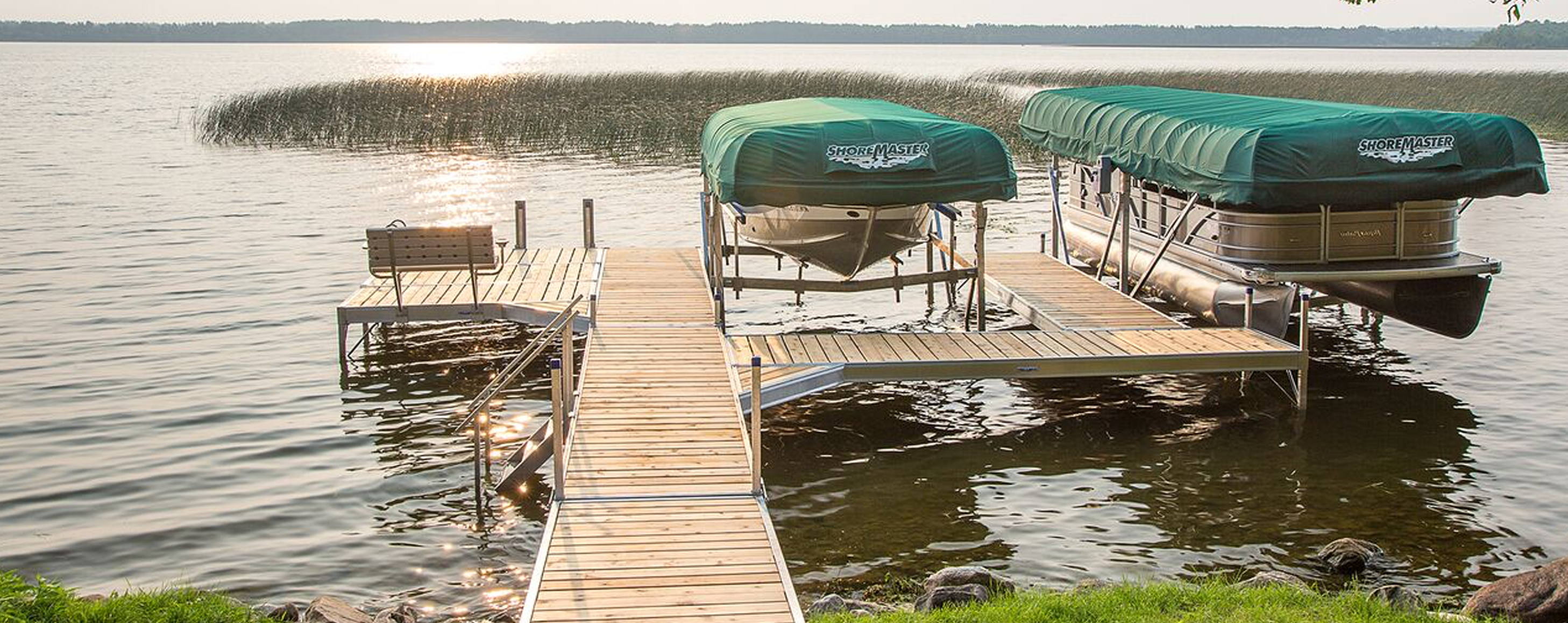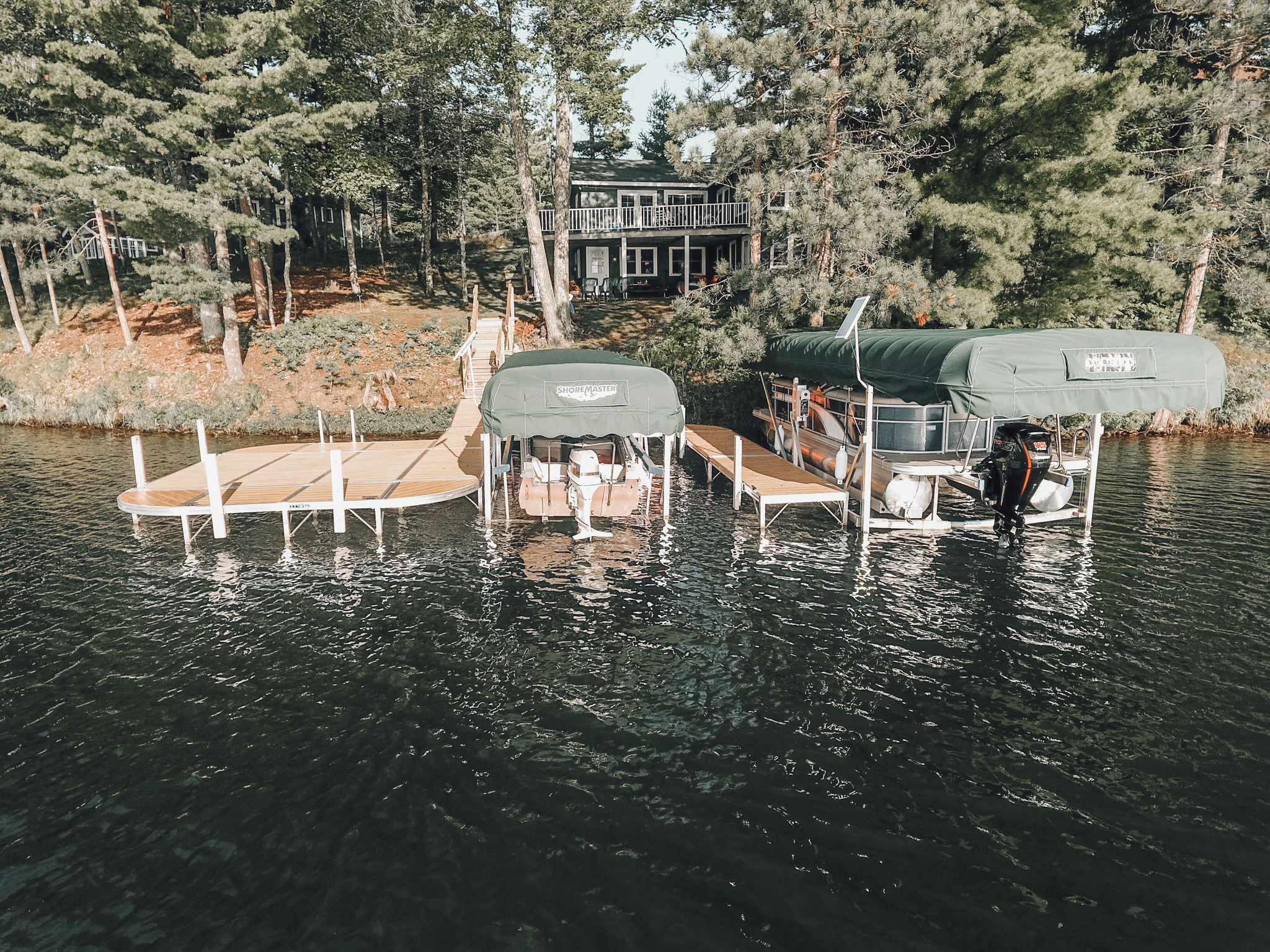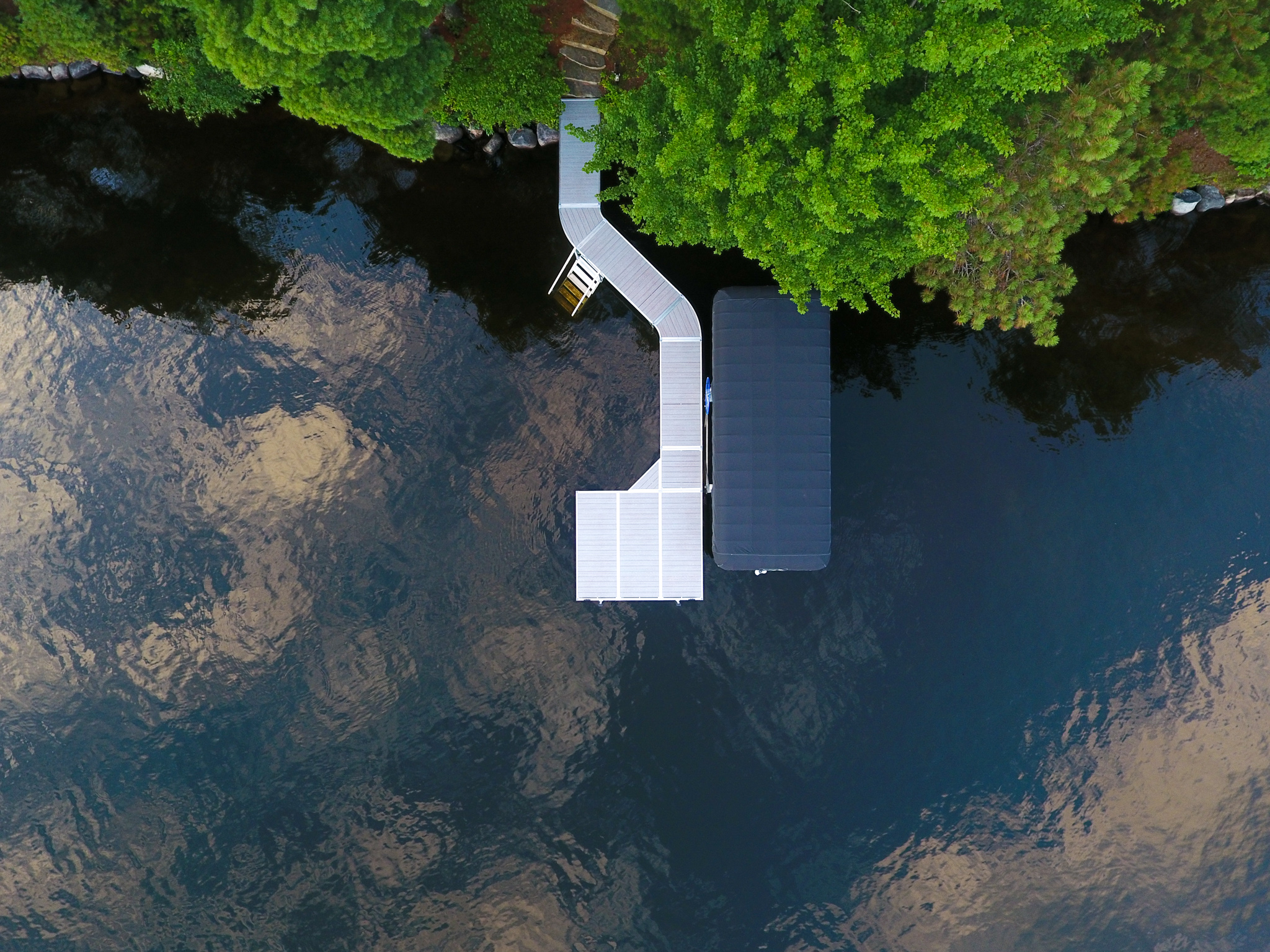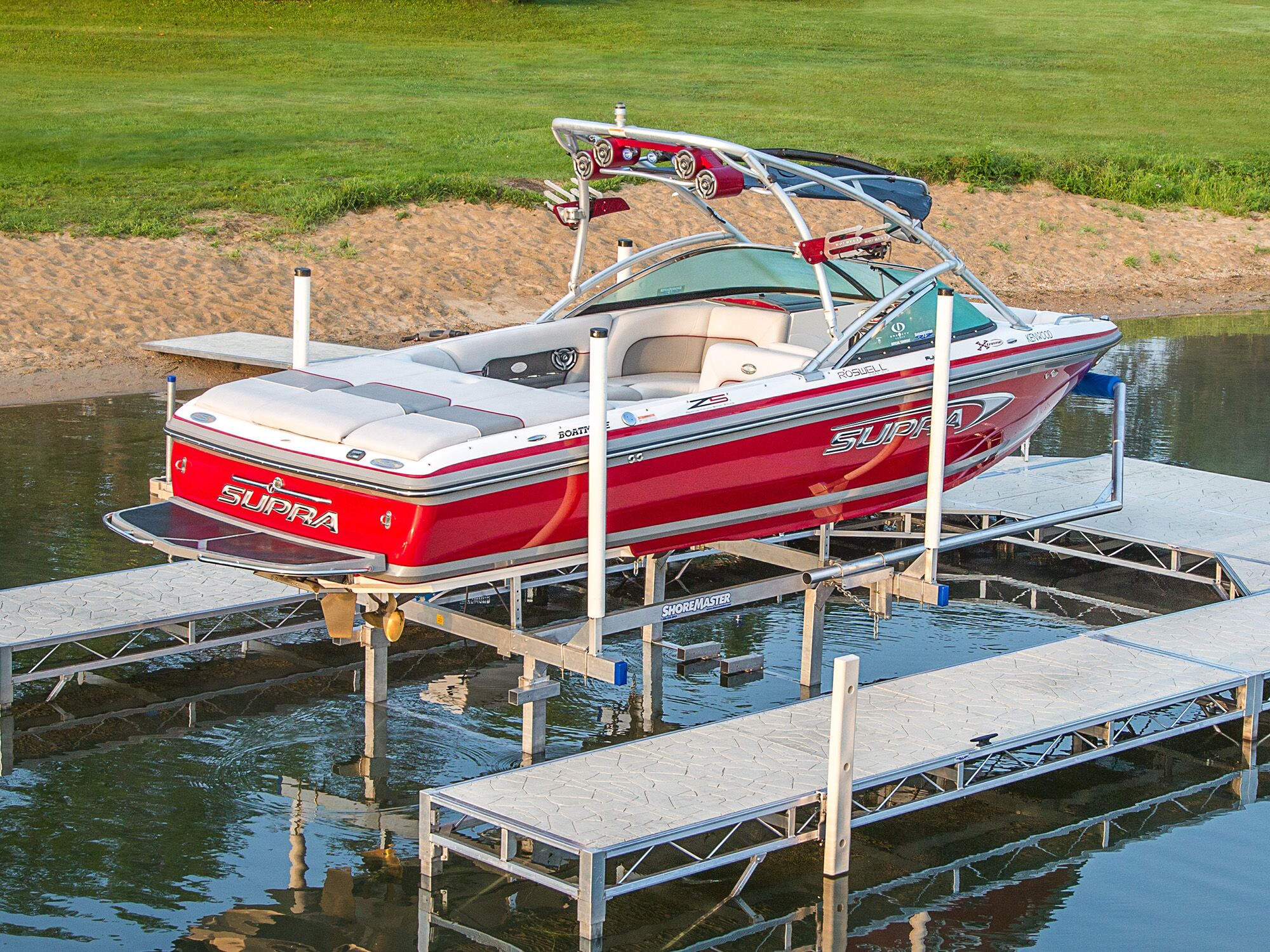Posted on May 1, 2025
Are Boat Lifts Worth It? Pros and Cons of Owning a Boat Lift
Written by ShoreMaster Marketing
For seasoned boaters, the answer to this question is obvious, as boat lifts offer one of the best ways to store, protect, and extend the life of a vessel. But for beginners and seasonal enthusiasts, the decision may not be as straightforward.
Below, we break down the key benefits of owning a boat lift, as well as potential drawbacks, to help you decide if it’s the right investment for your waterfront lifestyle.

Are Boat Lifts Worth It? Evaluating the Investment
Leaving a boat in the water for extended periods can lead to costly issues, including hull damage, biofouling, and wear from rough water conditions. The repairs required to address these problems aren’t cheap. Bottom cleaning and anti-fouling treatments can cost hundreds per year (Boating World, n.d.). Meanwhile, fiberglass hull repairs range from $500 for minor gel coating services to $5,000 for major structural work (The Pricer, 2024).
Then, there's the convenience factor. Often, the hassles associated with trailering can deter owners from enjoying their boats. Premium boat lift models enable owners to launch their vessels with a push of a button – no cumbersome trailer maneuvering, no heavy lifting, no waiting at public ramps, no stress. For many boaters, the convenience and long-term maintenance savings far outweigh the initial expense.
However, as with any significant purchase, whether this investment is "worth it" depends largely on your specific circumstances. Boat lift costs can range from around $4,300 to upwards of $28,000, depending on the capacity, features, and the necessary supporting structures (Vanquish Boating, Sept. 2023). As such, how often you use your boat, where it’s docked, and if you can justify the upfront costs will ultimately determine whether this investment aligns with your boating lifestyle.
Benefits of Owning a Boat Lift
Here’s what you get when you invest in a quality boat lift system:
- Enhanced Boat Protection: Prolonged water exposure fosters the growth of algae, barnacles, and other marine organisms that cling to the hull. Over time, this buildup not only detracts from the boat's appearance but can also increase drag and affect fuel efficiency. Moreover, leaving the boat on the water makes critical components, such as propellers, shafts, and through-hull fittings, more susceptible to corrosion. And that’s before you account for potential impact damage caused by rough water, traffic, and storm debris.
- Convenience and Accessibility: With most motorized lifts, launching your boat can be as simple as stepping onboard, pressing a button, and gliding effortlessly into the water. No more trailering back and forth – it’s ready to go when you are. For frequent boaters, the convenience and efficiency afforded by boat lifts enable them to maximize their time on the water, encouraging spontaneous adventures while enhancing their overall boating experience.
- Reduced Maintenance: Keeping your vessel elevated above the water when not in use significantly reduces the need for scrubbing marine growth and costly anti-fouling treatments. When it’s time for scheduled maintenance, a boat lift makes it easier to inspect and clean the hull, propeller, and other critical components that would otherwise require hauling the watercraft onto a trailer or paying for costly haul-out services. This ease of access encourages regular upkeep, which effectively extends the vessel’s lifespan while saving both time and money.
With a boat lift, you’re not just protecting your investment – you’re making boating easier, more enjoyable, and less time-consuming. It’s a game-changer for anyone who wants to spend more time on the water and less time dealing with maintenance and logistics.
Considerations Before Investing in a Boat Lift
Before you pull the trigger on that fancy floating boat lift for sale, here are some things to consider:
- Initial Investment Costs: Boat lift prices vary widely depending on the type, size, and features. While basic manual cable and winch systems start at around $5,000, high-capacity hydraulic systems can exceed $20,000. Beyond the purchase price, additional expenses like installation, dock modifications, and potential permitting fees add to the total upfront costs.
- Maintenance and Upkeep: Depending on the lift type, preventive maintenance tasks may include inspecting cables, pulleys, and motors, lubricating moving parts, topping up fluid levels, or checking for hydraulic system leaks. For reference, replacement cables typically cost $100 to $300. Meanwhile, motor or hydraulic system repairs can range from $500 to over $1,500, depending on the issue and the required boat lift parts.
- Environmental and Location Factors: When deciding whether to invest in a boat lift, it’s crucial to consider how your local environment might influence its performance and upkeep. For instance, fluctuating water levels caused by tides or rainfall can impact the stability and usability of certain lift types. At the same time, locations prone to extreme weather, such as high winds or storms, may require sturdier, more expensive systems.
Ultimately, investing in a boat lift is a decision that hinges on your personal needs, boating habits, and environmental conditions. With careful consideration, you can minimize the impacts of unforeseen challenges and get the most value out of your investment.
Types of Boat Lifts: Which One Suits Your Needs?
Here’s a brief overview of popular boat lift types:
- Hydraulic Boat Lifts: These systems use pressurized fluid to raise and lower boats. Compared to traditional cable lifts, hydraulic lift systems feature a push-button operation that offers a smoother, faster lifting and lowering cycle. However, this precision and ease of operation come at a premium, with higher upfront and maintenance costs.
- Cable-Drawn Boat Lifts: These lifts use a system of cables, pulleys, and winches to raise and lower vessels. Their simple design means they come at a lower price point than systems with more advanced lifting mechanisms. While you can add a motor to eliminate the need for manually cranking the wheel, cable-drawn boat lifts are still slower and noisier than their hydraulic counterparts.
At ShoreMaster, we offer a diverse range of boat lift models to suit boaters’ unique needs. Use our dealer locator to find boat lifts near me and get expert advice on finding the optimal solution for your needs.
Real-Life Experiences from Boat Owners
Ask any seasoned boater if you should invest in a boat lift, and they’ll likely say that if you can afford it, get it (Reddit, 2022). Keeping your vessel up on a lift just simplifies boating in a myriad ways:
- The hull stays much cleaner, which means less work cleaning off marine growth and applying anti-fouling paint. And, should anything go wrong with the boat, having a lift makes performing repairs so much easier.
- Your boat is never subject to banging or rubbing against the dock and nearby vessels during heavy wake or wave action.
- You have a ready-made storage solution for big storms and winter.
Anyone who’s ever had a boat lift will tell you the same thing, once you experience the convenience and peace of mind that boat lifts provide, there’s no going back.
Making the Decision: Is a Boat Lift Right for You?
Ultimately, deciding whether a boat lift is worth the investment comes down to your individual needs, boating habits, and environmental circumstances. Contact us today to discuss your requirements. Our team of waterfront experts can help you weigh your options and recommend the optimal solution for your unique needs.
FAQs
-
What factors should I consider when choosing a boat lift?
First, assess your waterfront characteristics, including bottom composition (muddy, sandy, rocky), average water depth, local regulations, and other environmental conditions that may impact boat lift installation and regular operation. For instance, muddy or soft bottoms may require reinforced anchoring systems to prevent the lift from sinking or shifting.
Additionally, the lift must be rated to support your fully loaded boat, including fuel, batteries, and all equipment and gear typically stored onboard. Check the vessel's spec sheet for its base dry weight and add 25%. Most seasoned boaters recommend getting the highest capacity lift you can afford to account for the inevitable upgrade.
-
Can a boat lift accommodate different types and sizes of boats?
The short answer is yes. At ShoreMaster, we produce various boat lift designs with capacities ranging from 2,200 to 32,000 lbs. We also offer customizable bunks and cradles to accommodate different vessel types and hull designs, from compact fishing boats and pontoons to larger sailboats and cruisers.
-
What is the average lifespan of a boat lift, and when should it be replaced?
The average lifespan of a boat lift typically ranges from 10 to 20 years, depending on factors like build quality, environmental conditions, and regular maintenance. However, replacement may be necessary when critical components like cables, motors, or structural elements show irreparable damage or excessive wear that compromises safety and functionality.
References:
- Boating World (n.d.). What is the cost to clean the bottom of a boat? Retrieved from https://www.boatingworld.com/question-answer/what-is-the-cost-to-clean-the-bottom-of-a-boat/
- The Pricer (May 7, 2024). How Much Does Fiberglass Boat Repair Cost? Retrieved from https://www.thepricer.org/fiberglass-boat-repair-cost/
- Vanquish Boating (September 7, 2023). Boat Lift Prices: A Comprehensive Guide. Retrieved from Boat Lift Prices 101 | Your Guide To Help Estimate Costs (vanquishboats.com)
- Reddit (2022). r/boating Keeping Boat in Water vs Boat Lift. Retrieved from https://www.reddit.com/r/boating/comments/swi2b5/keeping_boat_in_water_vs_boat_lift/



